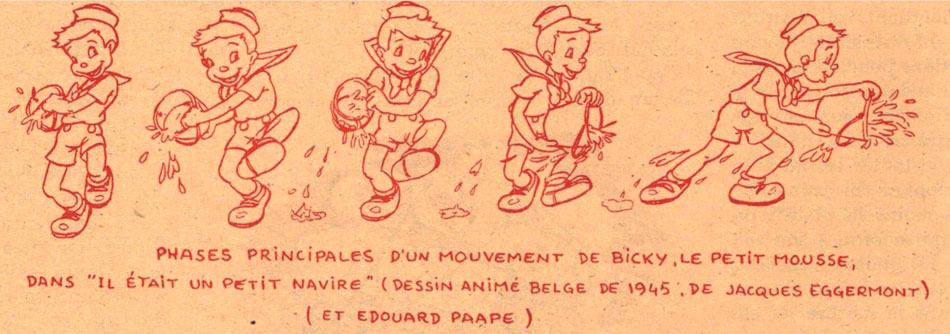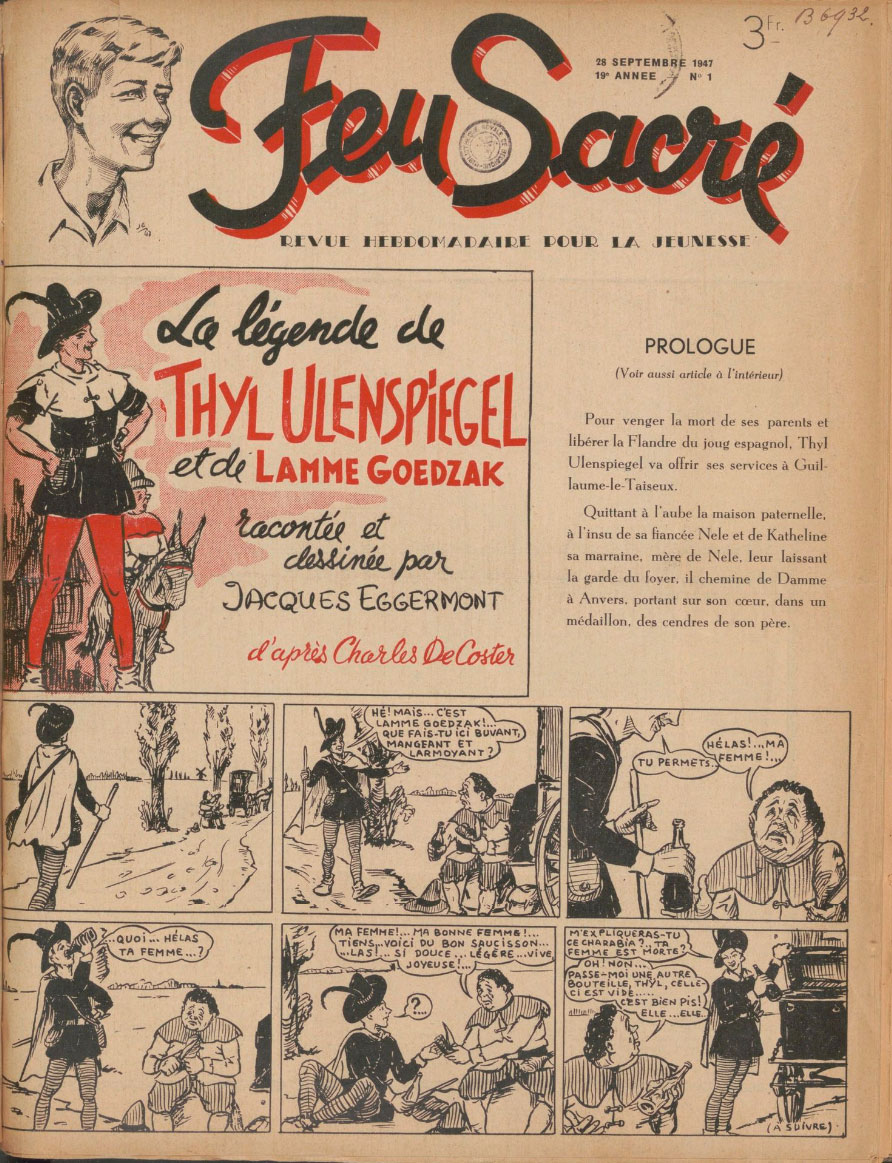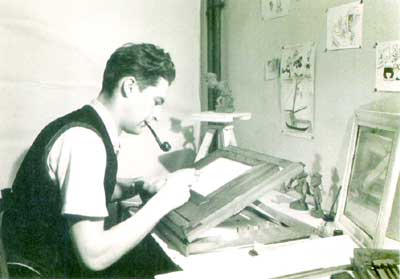Jacques Eggermont was a Belgian caricaturist, animator and comic artist, who flourished in the 1940s. During World War II, he worked for the small animation studio C.B.A., in a steady collaboration with Eddy Paape. The studio would have remained unnoticed in history, had it not launched the careers of four legendary post-war European comic artists: Paape, André Franquin, Morris and Peyo. In 1946-1948, Eggermont was also briefly active as a comic artist for Feu Sacré magazine, making the series 'Kaatje et Klopje' snd 'Tijl Uilenspiegel'. Due to bad luck and various unfortunate circumstances, Eggermont was never able to realize his ambitions to their full potential.
Early life and career
Born in 1918, Jacques Eggermont got his artistic education at the Institut Saint-Luc in Saint Gilles, near Brussels. Together with Eddy Paape, he enrolled at the section Arts and Decoration, initially focusing on a career as a painter. Disappointed by the curriculum - the mostly religious art assignments didn't meet up with the two artists' innovative ambitions - Eggermont and Paape switched focus to animation. One of their teachers in this profession was Carlo Queeckers. For their exams, Eggermont and Paape made the short animated film 'Peinture Animée', showing the seasonal changes of a landscape on the canvas. After their graduation, Eggermont and Paape offered their services to the French animator Jean Image, but were turned down.
Title card for Paape and Eggermont's C.B.A. productions.
Animation career
Paape and Eggermont's graduation film was however noted by Paul Nagant, owner of the Compagnie Belge d'Actualités (C.B.A.), a small animation studio based in Liège. Nagant had started his firm in 1937 to make news films for the cinema, but had switched to animation in 1940 after the Nazi oppressor had taken control of the news media. When his initial partnership with the Belgian animator Albert Fromenteau came to an end, Nagant hired Eggermont and Paape, who subsequently worked on various wartime projects under the anglicized and joint pen name Jackeddy. For Eggermont, animation was a true passion, for Paape more a way to make money so he could further develop his painting skills. So in their collaboration, Eggermont provided the artistic drive, while Paape secured a steady production rhythm.
After their first film 'Zazou Chez les Nègres' (1943), the C.B.A. team was working on the sequel, 'Zazou Gardien de Phare', when a fire burned down the original studio. While Eddy Paape ended up in the hospital, Jacques Eggermont resumed his work, and animated the popular songs 'Un Mètre Vingt... Une Brute!', 'La Petite Brosse à Rimmel's' and 'Y'a des Zazous dans le Quartier' for the film 'Image par Image'. These animated segments applied typical elements from comic strips, like thought balloons and exclamation marks above a character's head.
The character of the little sailor Bicky was created by Jacques Eggermont and Eddy Paape for an illustrated story on "how to make an animated cartoon" in Feu Sacré magazine (1947).
Near the end of World War II, C.B.A. relocated to Brussels, where the team was accompanied by young artists like André Franquin, Morris and Georges Salmon. They started working on 'Il Était Une Fois', another film based on popular songs, namely 'Il Était... un Petit Navire' and 'Le Chat d'la Mèr' Michel'. To supplement their income, the young artists additionally made picture stories for the magic lantern. In the summer of 1945, Jacques Eggermont left C.B.A. in April 1945 to fulfill his military service in Ireland, and was replaced by the young animator Pierre Culliford, who later became known as Peyo, the creator of the Smurfs.
Comics
When C.B.A. folded shortly after the war, most of Jacques Eggermont's former colleagues moved on to become important comic creators for the publishing house Dupuis. However, Eggermont didn't feel much for this medium. Using the pen name "Jack", he nevertheless made a couple of comics to make some money. Most of them appeared in the Brussels magazine Feu Sacré, the weekly organ of the Eucharistic Crusade and the Federation of Cadets (some sources erroneously say he worked for Franc Jeu, but that magazine had been out of print since August 1945). Between 8 December 1946 and 6 July 1947, Feu Sacré serialized Eggermont's comic 'Les Aventures de Kaatje et Klopje: Le Palais de Glace', followed between 28 September 1947 and 22 February 1948 by 'Le Bateau de Klopje'. In 1947, 'Kaatje et Klopje' was also published in Route Fière magazine.
Also on 28 September 1947, this time made under his own name, Jacques Eggermont's comic serial based on the Charles De Coster novel about the folkloric character 'Tijl Uilenspiegel' also started in Feu Sacré. Serialization concluded on 15 February 1948.
'La Légende de Thyl Ulenspiegel et de Lamme Goedzak' (Feu Sacré, 28 September 1947).
Return to animation
However, Jacques Eggermont's true passion was animation. In 1948, he began his own studio, L'Institut Photographique de Belgique. One of his studio apprentices was the future Belgian cinematographer Willy Kurant. With his assistant Julien Bal, Eggermont produced advertising films, but had more ambition for creating animated fiction films. He asked his old C.B.A. colleagues to join him, but they preferred to stick to their steady income at Dupuis. After two hard years, Eggermont's studios had to close its doors in 1950.
Eventually, Eggermont decided to write a letter to the Godfather of Animation, Walt Disney, adding a book with self-made sketches inspired by Disney's 'Snow White'. This was his last hope and he crossed fingers that Disney might give him some professional advice or a chance to work for him. Instead, the Disney Company sent him an angry letter, in which they threatened to sue him if he continued with this plagiarism. This response left Eggermont devastated and embittered, so he left the animation industry.
Final years and death
After his rejection by Disney, Eggermont drew caricatures and cover cartoons for the satirical weekly Pourquoi Pas?. After inheriting a fortune from his father, he left Pourquoi Pas? and settled in the South of France, where he lived in a trailer in a nudist camp. Jacques Eggermont eventually returned to Belgium to work as a piano tuner and painter, specializing in portraits and landscapes. Jacques Eggermont died in November 1998.
Jacques Eggermont working in his studio.







